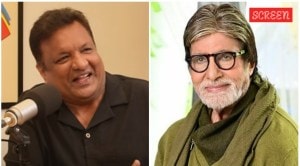The road to Mumbai
Thirty years ago when I shifted from Bombay — it had not yet been re-christened Mumbai — to Delhi I drew much sympathy for moving ...

Thirty years ago when I shifted from Bombay — it had not yet been re-christened Mumbai — to Delhi I drew much sympathy for moving from India’s urbs prima to a backwater. A city where public buses were few and far between and electricity breakdowns all too frequent. Even affluent areas like Defence Colony and Nizamuddin had smelly open drains running through them and it was unsafe for a woman to travel alone after 9 pm. Delhi’s markets were small and shabby and shut early. The restaurants offered little beyond Mughalai food, butter chicken, Punjabi Chinese and darkened interiors. Bombay was smart, sophisticated, savvy and cosmopolitan while Delhi, by contrast, was provincial, dull and downmarket.
Today it seems as if the roles are almost reversed. Visitors from Bombay gasp in awe at Delhi’s spaghetti flyovers, super modern metro, broad avenues and gigantic shopping malls. Most are particularly struck by how clean and green the city is when compared with Mumbai’s squalor and congestion. Nearly 60 per cent of Mumbai’s population of 15 million lives in slums and around two million have no access to toilets. While the quality of life in Delhi has steadily improved over the last quarter century, living standards in Mumbai have gone slowly downhill.
Today I feel like a stranger in the city I grew up in. The landmarks of my childhood — the bandstand at Cooperage, the gracious Victorian bungalows along New Marine Lines and the majestic marble statue of an imperious Queen Victoria minus her nose, which was knocked off by a revolutionary — have vanished. Flora Fountain which once stood in solitary splendour at the centre of the city’s business district is lost in the maze of a car park and overshadowed by oversized billboards from nearby buildings. The handsome colonial gothic buildings of the Fort are caked in grime; and the stench of rotting garbage and urine pervades.
The footpaths have become home to thousands. (Many years ago some of the city’s high profile, publicity hungry causerati even approached the Supreme Court with a PIL to argue that it was a fundamental right for people to squat on pavements). The have-nots and the carpetbaggers have taken over Mumbai, a city whose density is as high as 15,000 per square kilometre.
Bal Thackeray, Bombay’s big daddy whose stature has declined a trifle after the last election, blames Mumbai’s downfall on the relentless stream of outsiders who head for India’s sone ki chidya with stars in their eyes. Today less than half the city’s population are local Maharashtrians. Thackeray forgets that the demographic profile of most of our metropolitan cities has altered dramatically with time and yet they have coped. Many feel that in the Calcutta municipal limits there may be by now more Biharis and bhayias from eastern UP than Bengalis. In the wake of Partition, the old residents of Delhi were swamped by Punjabi refugees. In East Delhi today newcomers from UP and Bihar outnumber Punjabis.
A legitimate grievance of Mumbai residents is that though the city pays some 38 per cent of the country’s taxes, it receives scant financial assistance from the Central government, while Delhi by virtue of being the capital is flush with funds. Lack of Central assistance and waves of migrants may have played a part in vandalising the face of Bombay, but the real cause for the decline is that urban planning was totally ignored by greedy politicians who looked upon Mumbai as a milch cow for filling party coffers and lining their own pockets. For instance, the proposal to reclaim land at Nariman Point in order to construct a long line of skyscrapers at the already overcrowded southern tip of the island was Congress treasurer Rajni Patel’s brain wave for raising party funds. Nariman Point came up at the expense of the development of New Bombay which would have served as a counter magnet. In contrast, the National Capital Region (NCR) in Delhi’s hinterland has contributed enormously to de-congesting the city.
Rapacious building contractors threw around enough money and managed to change residential areas into commercial zones and alter building bye-laws in their favour. Overnight rows of two-storey houses were knocked down to make way for multi-storey office complexes constructed without the necessary infrastructure, from parking space to running water and sewage lines. To accommodate the ever increasing population, new slum colonies kept sprouting alongside suburban railway lines and water pipelines and there were enough vested interests at work to ensure that they would not be re-located.
Once the rule of law was given short shrift, the rot set in. If Delhi has so far avoided the fate of Bombay it is because fortunately no single authority can take decisions which would have a far reaching impact on the city’s future. Local politicians invariably plump for shortsighted pragmatic solutions which pander to special interest groups and votebanks at the expense of the city as a whole. Delhi’s politicians too have pushed for such populist measures as changing the Master Plan by increasing the floor area ratios, altering zoning laws, liberalising building bye-laws so that an extra floor is permitted, regularising unauthorised colonies and so on. If such proposals have been scuttled in the past it is thanks largely to the courts and the Delhi Development Authority, which is under the control of the Central government.
But the recent decision of the Congress state government to amend the Master Plan and thus defy the court’s order to transfer out of Delhi some 100,000 polluting industries in residential areas has been cleared by the DDA without any protest. And for once the opposition BJP is on the same side as the ruling party. Madan Lal Khurana, keen to find relevance in local politics, has always proudly proclaimed that people must take priority over plans. In the past, it was the firm stand of the Centre — thanks to the commitment to the city of people of stature like Jawaharlal Nehru, Indira Gandhi and Jagmohan — which prevented undue subversion of Delhi’s Master Plan. But with Urban Development Minister Ghulam Nabi Azad shirking his responsibility, it is now up to saner counsel, such as Prime Minister Manmohan Singh and UPA Chairperson Sonia Gandhi, to prevent Delhi sliding downwards the Mumbai way.
Photos




- 01
- 02
- 03
- 04
- 05



























